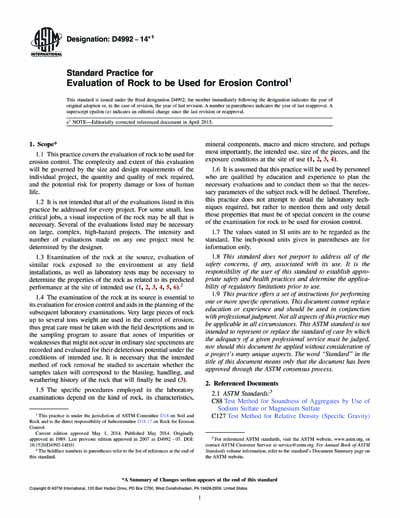Most recent
ASTM D4992-14e1
Standard Practice for Evaluation of Rock to be Used for Erosion Control
1.1 This practice covers the evaluation of rock to be used for erosion control. The complexity and extent of this evaluation will be governed by the size and design requirements of the individual project, the quantity and quality of rock required, and the potential risk for property damage or loss of human life.
1.2 It is not intended that all of the evaluations listed in this practice be addressed for every project. For some small, less critical jobs, a visual inspection of the rock may be all that is necessary. Several of the evaluations listed may be necessary on large, complex, high-hazard projects. The intensity and number of evaluations made on any one project must be determined by the designer.
1.3 Examination of the rock at the source, evaluation of similar rock exposed to the environment at any field installations, as well as laboratory tests may be necessary to determine the properties of the rock as related to its predicted performance at the site of intended use (1, 2, 3, 4, 5, 6).2
1.4 The examination of the rock at its source is essential to its evaluation for erosion control and aids in the planning of the subsequent laboratory examinations. Very large pieces of rock up to several tons weight are used in the control of erosion; thus great care must be taken with the field descriptions and in the sampling program to assure that zones of impurities or weaknesses that might not occur in ordinary size specimens are recorded and evaluated for their deleterious potential under the conditions of intended use. It is necessary that the intended method of rock removal be studied to ascertain whether the samples taken will correspond to the blasting, handling, and weathering history of the rock that will finally be used (3).
ASTM International [astm]

